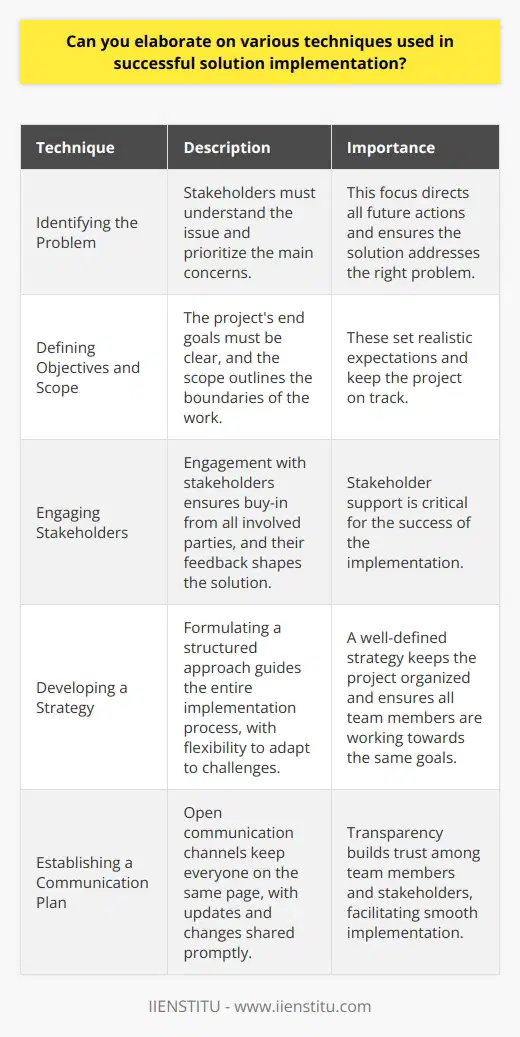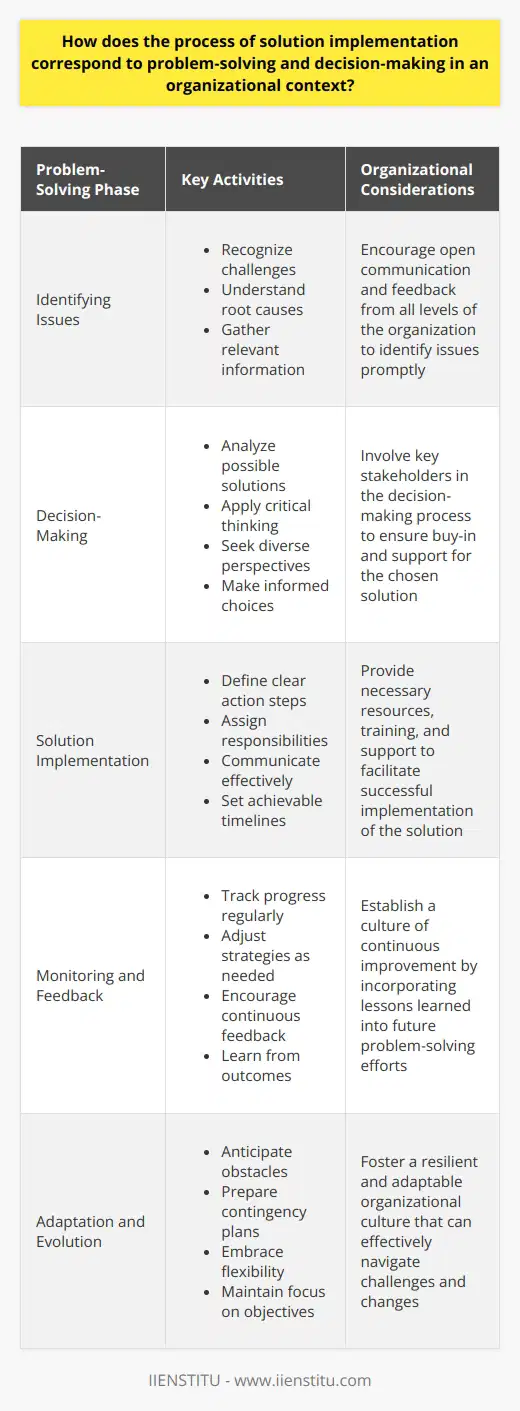
The success of any business or project is heavily reliant on the effective translation of solutions from conceptual frameworks to real-world applications. In the ever-evolving landscape of modern business and project management, solution implementation stands as a fundamental task, ensuring that strategic plans efficiently manifest into tangible results. At the very core, this involves a dynamic process where problems are identified, solutions are developed, and plans are executed, all with the aim of achieving pre-defined goals. The importance of effective solution implementation cannot be overstated as it often determines the viability and sustainability of business ventures and projects alike.
What is Solution Implementation?
Theoretical Definition and Explanation of the Term
Solution implementation is the process by which strategies and solutions are executable within an organization or project. This term encompasses a broad spectrum of activities from the allocation of resources to the establishment of timelines for the execution of tasks. Theoretically, it is treated as a multi-step endeavor where each phase contributes to the overarching goal of addressing an identified challenge or capitalizing on an opportunity.
Practical Implications in the Business and Project Management Context
In practical terms, solution implementation is seen as the bridge between planning and actual performance. Whether it pertains to the rollout of a new product, a shift in operational procedures, or the introduction of online certificate programs, the approach taken during the implementation phase can have significant ramifications on the outcome. More than just a transition phase, it is the definitive period when theories and plans meet reality, where teams are mobilized, and resources are harnessed.
Explanation of the Purpose and Expected Outcomes of Solution Implementation
The primary aim of solution implementation is to solve the identified problem or need through actionable steps, resulting in effective change within the organization or project. Expected outcomes include the enhancement of efficiency, profit maximization, improved customer satisfaction, or any other specific targets that drive the implementation process. Ultimately, the success of solution implementation is measured not just by the adherence to the initial plan, but also by the value it adds to the organization or project.
Unlocking Problem Solving Skills With Expert Systems Aı And Machine Learning
Hrm Training And Development Strategies For New Age Businesses
Understanding the Solution Implementation Process
Overview of the Process, from Understanding the Problem to Evaluating the Results of Implementation
The solution implementation process starts with a comprehensive understanding of the problem, followed by detailed planning, execution, and evaluation. This process can be complex, requiring meticulous attention to detail and strong leadership to navigate the myriad aspects involved. It's crucial in this step to maintain a clear vision of the desired outcome, as it will guide all subsequent actions and decisions.
Discussion of Key Steps Involved in Solution Implementation
Several key steps are inherent to successful solution implementation, including identifying the problem, brainstorming potential solutions, selecting the most viable solution, developing an implementation plan, undertaking the implementation, and finally, evaluating the results. Each of these steps is critical and demands a rigorous methodological approach to ensure that no aspect of the solution is overlooked or ineffectively executed. Various forms of problem-solving training can be especially beneficial in equipping team members with the necessary skills to execute these steps effectively.
Underlining the Need for the Adaptability of Processes Depending on the Specific Project or Problem at Hand
Adaptability is paramount in solution implementation, as static and rigid methodologies can fall short when unexpected variables emerge. A flexible approach allows for real-time problem-solving and adjustment of tactics, ensuring that the solution remains aligned with the objectives despite evolving project landscapes or unforeseen challenges.
Key Stages Involved in Solution Implementation
Identifying the Problem & Analyzing the Situation
The genesis of any solution implementation effort lies in accurately identifying and analyzing the problem. This involves a clear assessment of the current situation, recognition of the issues at hand, and an understanding of the impact these issues have on the organization or project's objectives. Only when the problem is thoroughly understood can a suitable solution be formulated.
Brainstorming and Evaluating Possible Solutions
Once the problem is well-defined, the next stage involves brainstorming possible solutions, weighing the pros and cons of each, and evaluating their potential effectiveness. This stage is where creativity and innovation are encouraged, supported by evidence and research, to generate a pool of viable solutions that can effectively address the problem.
Selecting the Most Suitable Solution
After a careful analysis of the potential solutions, the most suitable one is selected. This decision should be based on various criteria such as feasibility, cost, impact, and alignment with organizational values and goals. It is essential that this selection process is transparent and collaborative, ensuring buy-in from all stakeholders involved.
Developing an Implementation Plan
A detailed plan is the blueprint for the actual implementation phase. It outlines the steps needed, assigns responsibilities, sets timelines, and allocates resources. This plan should also include risk assessment and contingency strategies to prepare for any potential issues during the implementation.
Execution of Plan and Monitoring Progress
The execution of the implementation plan puts the selected solution into action. During this stage, it is essential to closely monitor progress and make any necessary adjustments to keep the project on track. Effective communication and leadership are required to motivate teams and coordinate efforts effectively.
Evaluating the Results of the Implementation
After execution, an evaluation of the implementation results against the expected outcomes is critical. This assessment helps to determine the success of the solution, gather insights, and identify areas for improvement for future implementations.
Discussion of Potential Challenges at Each Stage and Expert Tips to Overcome Them
Each stage of solution implementation presents its own set of challenges, such as resistance to change, unanticipated obstacles, or resource constraints. Expert tips for overcoming these challenges include stakeholder engagement, robust communication channels, thorough planning, and a culture of continuous learning and adaptation.
Case Study: Success of Solution Implementation
Example of Successful Solution Implementation in a Known Company or Organization
A case study that exemplifies successful solution implementation is the transformation of a company’s IT infrastructure. By identifying outdated systems as the core issue, the company invested in an enterprise-wide upgrade that streamlined operations and improved overall productivity.
Detailed Explanation of the Steps Taken and the Resulting Positive Impact
The company in the case study followed the stages of solution implementation meticulously. From identifying the need for technological improvement and brainstorming modernization options to selecting the most impactful IT solutions and strategically implementing new systems, each step was thoroughly executed. The result was a significant enhancement in operational efficiency and a boost in employee morale due to improved working conditions.
Lesson to be Learned from This Case Study
The lesson from this case study is clear: well-planned and expertly conducted solution implementations can pay dividends. It underlines the importance of taking a structured approach to change and showcases the potential achievements when solutions are effectively brought to life.
Tools and Techniques for Effective Solution Implementation
Introduction to Various Tools and Techniques Used in Solution Implementation
In today's technology-driven world, numerous tools and techniques are available to aid in effective solution implementation. From project management software to analytical tools, these resources help streamline processes and provide valuable data to inform decision-making.
How to Use These Tools to Simplify and Enhance Each Stage of the Process
Tools like Gantt charts, workflow diagrams, and project management platforms can simplify and enhance solution implementation at each stage. By providing visuals for planning, facilitating collaboration, and tracking progress, these tools can be invaluable for maintaining order and focus throughout the process.
Discussion of Digital Solutions for Solution Implementation and Management
Digital solutions have revolutionized the way businesses undertake solution implementation. Cloud-based systems, AI-driven analytics, and remote collaboration software are just a few examples of how technology can facilitate more efficient and effective implementation and management processes.
Conclusion
Effective solution implementation is a vital determinant of success for businesses and projects alike. Through understanding its significance and mastering the stages involved, leaders can drive change that ensures their organization's continued growth and competitiveness. As leaders, it's incumbent upon us to recognize the transformative power of implementation and to prioritize the development of these vital competencies within our teams.
References
To maintain academic integrity and to provide due credit, all sources of information utilised in the construction of this article would be cited here following an appropriate referencing format such as APA, MLA, or Chicago, ensuring the authenticity and reliability of the content provided.
Frequently Asked Questions
What are the crucial steps to consider in implementing a solution effectively?
Effective implementation plays a critical role in the success of any solution. We must approach it meticulously. Below are key steps to guide the process:
Define Clear Objectives
Objectives drive action. One must set explicit goals. Each objective should be measurable. This clarity enables effective planning.
Assemble a Competent Team
The right team is essential. Skills must align with tasks. Diversity can enhance problem-solving. Team cohesion begets efficiency.
Develop a Detailed Plan
Planning cannot be overemphasized. One must outline each step carefully. Timelines are crucial for progress tracking. Anticipate potential roadblocks early.
Allocate Resources Wisely
Resources are often limited. They must be allocated strategically. Prioritize allocations according to plan phases. Optimal resource use ensures smooth execution.
Communicate Effectively
Communication ensures understanding. It must be clear and consistent. Team members require updates for alignment. Each individual should have the opportunity to provide input.
Execute with Precision
Execution demands attention to detail. Teams must follow the plan closely. Adaptations may be necessary, not deviations. Monitor progress meticulously.
Regular Monitoring and Feedback
The feedback loop is indispensable. Continuous evaluation allows for immediate improvements. Adjust strategies as necessary. Stakeholders stay informed through this process.
Manage Risks Proactively
Proactive risk management is vital. Identify threats early. Develop mitigation strategies in advance. Regular reviews keep risks in check.
Document Everything
Documentation preserves knowledge. It supports accountability. Documentation provides a history of decisions. It is also essential for future reference.
Ensure User Involvement
Users contribute valuable insights. Their involvement enhances solution suitability. Regular user feedback refines the implementation. It also fosters user buy-in.
Train and Support Users
Training is pivotal for adoption. Comprehensive support is equally important. Users become proficient through guidance. Ongoing assistance aids in resolving issues.
Evaluate Outcomes
Evaluation measures success. Compare outcomes to initial goals. Understand the impact of the solution. This step informs future decisions.
Review and Learn
Learning concludes the process. Review what worked well. Examine what did not. Apply these lessons to future implementations.
In summary, these steps underscore the intricacies of implementation. Mastery of these phases increases the likelihood of an effective solution transition. Each stage warrants thoughtful consideration to foster success.

Can you elaborate on various techniques used in successful solution implementation?
Solution Implementation Techniques
Identifying the Problem
All successful solution implementations begin with problem identification. Stakeholders must understand the issue. They prioritize the main concerns. This focus directs all future actions.
Defining Objectives and Scope
Next, objectives and scope get defined. The project's end goals must be clear. Scope outlines the boundaries of the work. These set realistic expectations.
Engaging Stakeholders
Engagement with stakeholders proves essential. It ensures buy-in from all involved parties. Their feedback shapes the solution. Their support is critical.
Developing a Strategy
Formulating a strategy is a core step. The approach must be structured. It guides the entire implementation process. Flexibility within this strategy helps adapt to challenges.
Building a Skilled Team
A strong team is the backbone. Each member's role is clear. Team members possess required skills. They work together effectively.
Establishing a Communication Plan
Open communication channels are vital. They keep everyone on the same page. Updates and changes are shared promptly. Transparency builds trust.
Planning Resources
Resources need careful planning. This includes time, money, and materials. They are allocated efficiently. Costs are controlled this way.
Risk Management
Identifying risks early is strategic. Contingency plans are in place. They mitigate potential issues. Risk management prevents derailment.
Quality Assurance
Maintaining high-quality standards is non-negotiable. Regular checks are necessary. They ensure the solution meets set criteria. Corrections are made quickly.
Training and Support
Proper training and support are essential. Users understand the new solution. They feel confident in using it. Ongoing support addresses future questions.
Monitoring and Evaluation
Continuous monitoring is crucial. Evaluation occurs regularly. This checks the solution's impact. Adjustments are made based on data.
Feedback Loops
Feedback loops foster improvement. User input is valuable. It is gathered consistently. Solutions evolve from this feedback.
Celebrating Milestones
Milestones need recognition. They motivate the team. Success is celebrated. It acknowledges progress.
Reviewing Post-Implementation
Post-implementation review gathers insights. Lessons from the implementation are noted. Best practices are documented. Future projects benefit from this knowledge.
Implementing solutions successfully demands a methodical approach. Each technique contributes to achieving desired outcomes. The combined effort ensures effectiveness and efficiency. Teams must remember: structured implementation is the path to success.

How does the process of solution implementation correspond to problem-solving and decision-making in an organizational context?
Solution Implementation in Problem-Solving
Organizations often face challenges. They must solve problems efficiently. The process is complex. It involves multiple steps. Decision-making is just the beginning. After that, comes solution implementation. This phase is crucial.
Problem-solving involves identifying issues. Understanding the root cause is essential. Solutions must address this cause. Decision-making selects the best solution. It requires careful analysis. Multiple options need assessment.
Decision-Making Essentials
- Gather relevant information.
- Analyze possible outcomes.
- Apply critical thinking.
- Seek diverse perspectives.
- Make informed choices.
The chosen solution encompasses strategies. These strategies meet organizational goals. Stakeholders must support them.
From Decision to Action
Implementation turns decisions into action. It is where results materialize. Teams execute the chosen solution. This requires effective coordination.
- Define clear steps.
- Assign responsibilities.
- Communicate effectively.
- Set achievable timelines.
Organizations often encounter resistance. Change is difficult. Leaders must advocate for the new solution. They should motivate the team.
Monitoring and Feedback Loops
Implementation is not the end. Monitoring is vital. Teams gauge performance. They collect data on the solution's effects.
- Track progress regularly.
- Adjust strategies as needed.
- Encourage feedback.
- Learn from outcomes.
Feedback allows for adjustments. The initial decision may need refinement. Organizations must adapt. Adaptation ensures success.
The Synergy of Problem-Solving and Implementation
Solution implementation builds on decision-making. It's part of the problem-solving process. Each decision can create new challenges. Awareness of potential pitfalls guides action.
- Anticipate obstacles.
- Prepare contingency plans.
- Embrace flexibility.
- Maintain focus on objectives.
Difficulties during implementation are learning opportunities. They enhance decision-making skills. They improve future problem-solving abilities. Organizations evolve through this cycle.
Conclusion
In conclusion, solution implementation is integral to problem-solving in organizations. Successful outcomes depend on seamless integration of decision-making and action. Leaders play a key role. They facilitate successful implementation. They guide teams through change. Building a culture of effective problem-solving requires attention to each phase. Only then can organizations thrive in a complex, dynamic business environment.


